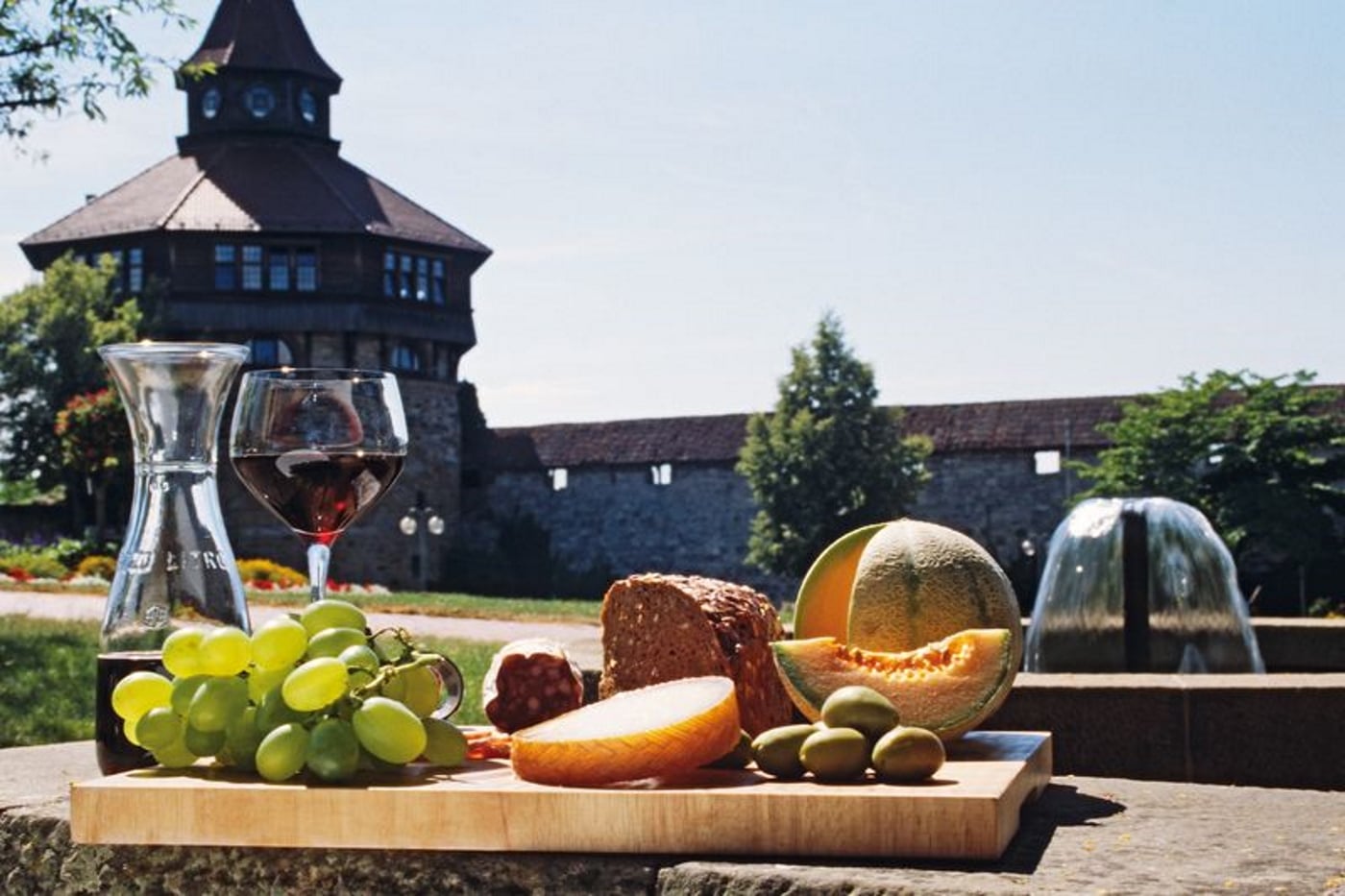It’s no longer a secret: Germany is one of the great culinary destinations in Europe. Forget its old reputation for stodgy meat-and-potatoes fare. In Germany today you can eat very well indeed, from traditional regional dishes to the latest modern cuisine.
This year German restaurants racked up a total of 282 Michelin stars, including more 3-starred restaurants than any other European country except France. Innovative chefs—from young newcomers to long-established professionals—take pride in preparing foods that showcase local, regional, and seasonal products. For many chefs, sustainability is a guiding principle in sourcing ingredients for their kitchens, just like it was for their ancestors who lived on farms. Many home cooks and professional chefs also use only Bio (organic) products, making Germany second only to the U.S. in consumption of organic foods.
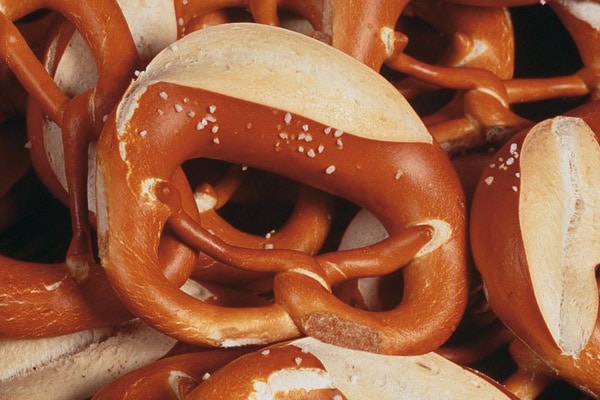
For a nation slightly smaller than Montana, Germany has a surprisingly large number of distinct culinary regions, 13 designated wine regions, and more than a thousand breweries that make some of the best beer in the world. North to south, east to west, from the mountains to the sea, local specialties are as varied as Germany’s terrain. Food, wine, and beer festivals fill the calendar year round. And several well-marked regional driving routes lead to the farms, dairies, breweries, and wineries that produce the best Germany has to offer.
So come join me on a culinary tour to the four corners of Germany, where food traditions are rooted in the past but interpreted in myriad ways by today’s fine cooks.
Southern Cooking
With its alpine peaks and fairytale castles, south Germany is one of the most popular tourist destinations in the country. Millions travel to Munich just to attend the city’s annual Oktoberfest, the world’s largest beer bash. But savvy travelers also know the food in this part of Germany is as good as the beer. Traditional festival fare includes giant soft pretzels, Obatzter savory cheese spread, crispy rotisserie chicken, smoky grilled fish, and addictive sugar-roasted almonds. Outside the O’fest grounds, Munich’s restaurants serve up some of the best foods in Bavaria, from modern German cuisine to old-style farmhouse dishes like grandma used to make.

The Baden wine district and the Black Forest, both in southwestern Germany, offer some of the finest food in the country. Even the French cross the Rhine to eat there. As one of Germany’s premier wine regions, Baden produces whites, reds, and rosés that have garnered international awards. And Baden boasts more Michelin-starred restaurants than any other part of Germany. Even the little Black Forest town of Baiersbronn (population 14,000) has three restaurants awarded a total of eight Michelin stars. Many of Baden’s acclaimed chefs attribute their success to making new versions of classic dishes, without abandoning their culinary roots.
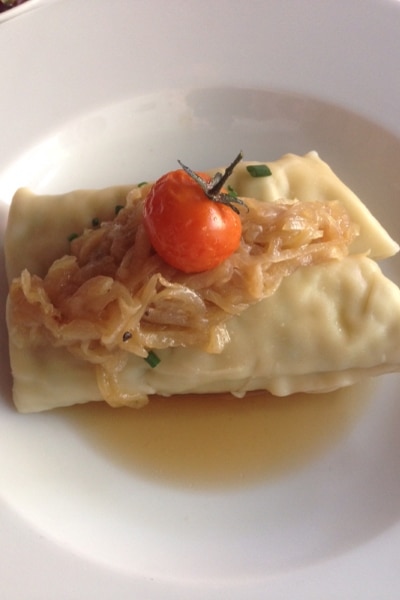
Succulent snails from the vineyards show up in soups and appetizers. Fish from the rivers and streams—especially trout, salmon, and eel—is an important ingredient in Baden cuisine. Black Forest ham—salt-cured, air-dried, and sometimes smoked—is famous far beyond the borders of Baden, as is creamy, chocolatey, Black Forest Cherry Cake. And many a meal ends with a glass of Schnaps, clear liquor distilled from the wide variety of fruits and berries that grow in the Black Forest.
From Baden to Bavaria, favorite vegetables include tall, conical, Filder green cabbage and freshly picked thick white asparagus. Pasta dishes are popular, too, such as the traditional Schwabian regional specialties, Maultaschen (giant ravioli) with a variety of stuffings, and Spätzle, little flour-and-egg dumplings often combined with cheese from the alpine Allgäu region to make Germany’s own version of mac ‘n’ cheese. And no Christmas would be complete without little white, anise-flavored Springerle cookies imprinted with intricate designs made with carved wooden molds.
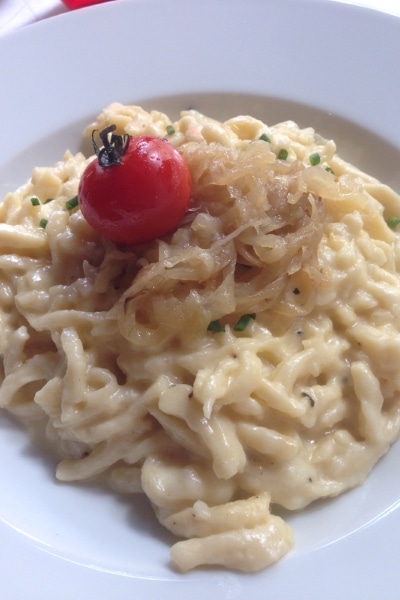
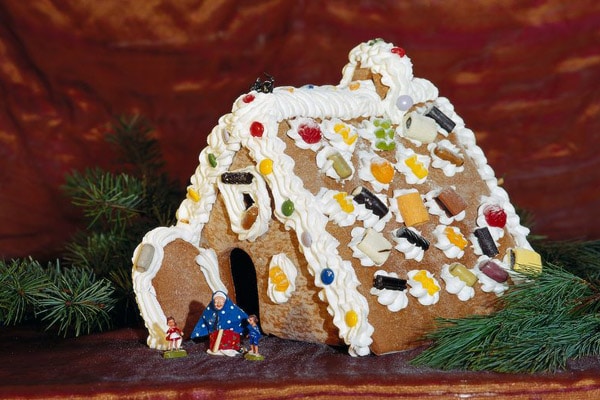
In the Franconian part of southern Germany, Nürnberg has been a major center of Lebkuchen (gingerbread) baking since the Middle Ages. Nürnberg now produces tons of these honey-spice cookies annually, many of them packaged in colorful tin boxes and shipped all over the world. Franconia is also well known for its wines and beers. Travel the Franconian wine route, on both sides of the Main River, to sample the local wines sold in distinctively shaped green wine bottles known as Bocksbeutel. Franconia also boasts more breweries per square kilometer than anywhere on Earth. The Baroque city of Bamberg, the center of the regional brewing industry, is famous for its dark, smoky-flavored Rauchbier, made from malted barley smoked over beechwood.
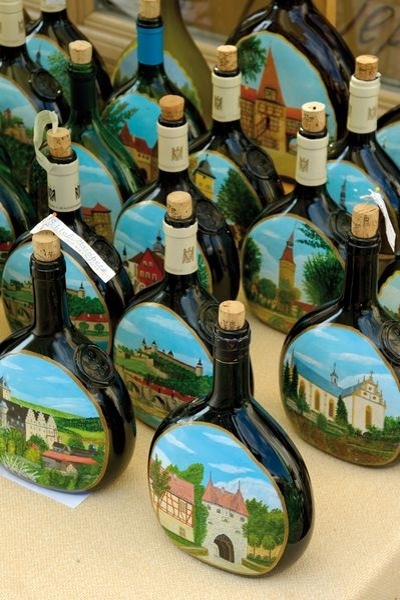
Best of the West
The Rhine and Mosel rivers meander through one of the Germany’s most scenic regions, where vineyards have covered the steep hillsides since Roman times. Today many of Germany’s best known wines are made in this western part of the country, which encompasses seven of Germany’s 13 official wine regions. Connoisseurs will be able to taste the difference between wines from one vineyard to another.
An old saying claims “Where there’s good wine, there’s good food.” And a fun way to sample those foods is at the hundreds of wine festivals, often combined with food fairs, held in this region between March and late October. A popular pairing is Federweisse and Zwiebelkuchen. Federweisse (also called Neuer Wein) is a special drink available only during the grape harvest season in the autumn, when vintners siphon off some of the bubbly, yeasty grape juice that’s still in the process of fermenting into wine. The classic accompaniment to this refreshing, cloudy-beige drink is a slice of Zwiebelkuchen, a savory egg-and-onion tart often seasoned with bacon.
Wines are also ingredients in many of the regional food specialties, such as river trout or Mosel eel in creamy Riesling wine sauce, chicken braised in Riesling, vineyard snails fried in wine batter and served with a wine sauce, and boozy desserts like Riesling cream pudding and sweet strawberry-rhubarb soup made with Rhine or Mosel wine. Venison and wild boar from the forests are served with sweet-tart Preiselbeeren sauce, similar to American cranberry sauce. And pork dishes of all kinds are just as popular here as elsewhere in Germany. Grape pickers along the Rhine and Mosel used to stop for lunch in the vineyards to eat a hearty casserole of wine-cooked pork or sausages layered with sauerkraut and mashed potatoes, partially prepared at home, and then reheated in the vineyards over an open fire made of grapevine prunings. Today this traditional dish is more likely to be cooked entirely at home, and then served to the grape pickers outdoors from the back of the vintner’s 4-wheel drive van.
Northern Bites

The cooking of North Germany is strongly influenced by its long coastlines on the North Sea and the Baltic Sea. Fish and seafood are the primary proteins eaten in this region, followed by salt-meadow lamb and pork raised in the interior. More than 100 species of sea creatures are pulled out of the nearby waters, from herring, flounder, and turbot to lobsters, mussels, and oysters. And inland rivers and lakes provide their own bounty of freshwater fish and crayfish.

Small, artisanal, home butchers turn farm-raised pigs into Katenschinken, the “cottage-smoked” ham of the north. Cabbage, kale, asparagus, and strawberries flourish in the sandy soil. And along the coastal sand dunes, prickly Sanddorn shrubs ripen with bright-orange, vitamin-rich sea buckthorn berries, known as “the lemon of the North,” which are made into dozens of products from juices, liquors, and berry wines to jams, relishes, and sweets.
Soups start many a meal: hearty potato soup or foamy beer soup with bacon and croutons, cream of salmon soup with dill dumplings, northern-style “bouillabaisse” and other fish soups containing North Sea Krabben, the tiny pink shrimp especially popular in this part of Germany.
Main dishes feature meats paired with the fruits and berries that grow here. Pork is baked in a pumpernickel crust and served with beer sauce. Colorful Labskaus, a classic sailors’ dish, consists of beef-and-beet hash topped with a fried egg and garnished with pickled herring and pickled gherkins. Pan-fried filets of North Sea salmon, cod, and pike-perch are topped with mustard sauce and crayfish tails, surrounded by pan-fried potatoes, and served in an iron skillet. And an old farmhouse dish now found on restaurant menus combines fresh green beans with thick slices of smoked bacon and pears.
Many meals end with a dessert of Rote Grütze, a dark red pudding made from cherries and berries and served with a vanilla sauce. Traditional drinks include both hot tea, especially popular in North Germany, and Pharisäer, tall cups of hot black coffee spiked with rum and topped with whipped cream. And everyone loves marzipan from the North German city of Lübeck, where this almond-paste-and-sugar confection is shaped into more than 300 different forms, from pastel-colored fruits to little sea creatures to replicas of cell phones.
Treats in the East

The culinary traditions of eastern Germany have been shaped by its geography and history. The low-lying landscape of forests, fields, rivers, and lakes has always been the main source of food: whitefish, zander, and carp; ducks, geese, and other waterfowl; wild venison, boar, and rabbit; wild garlic, mushrooms, and berries; grains and greens; orchards brimming with apples, pears, and plums; and a variety of vegetables, from the white asparagus of Beelitz to the onions of Weimar to the tender turnips of Teltow.
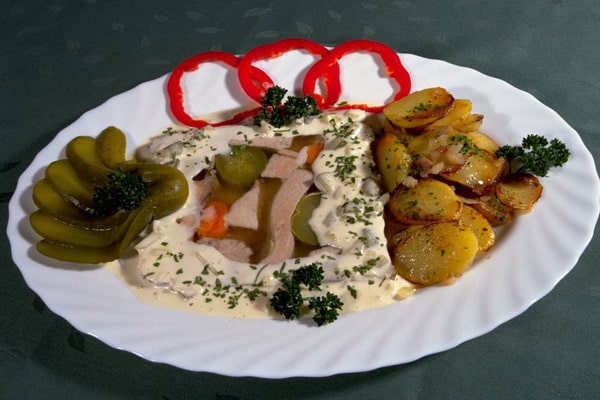
Sweet-and-sour flavors are especially popular here: red cabbage braised with sugar and vinegar; Sauerfleisch, shredded pork or goose flesh preserved in sweet-sour jellied aspic; poached or boiled eggs in sweet-sour bacon sauce; and the special cucumbers from the Spreewald area, pickled in brine seasoned with bay leaves, onions, sugar, and dill.
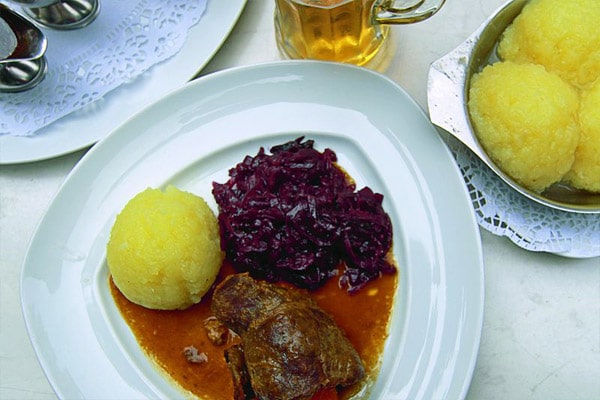
Although sausage and dumplings are devoured all over Germany, those eaten on their home soil in the eastern state of Thuringia have a reputation all their own. Big juicy Thuringer sausages, seasoned with nutmeg, marjoram, and other spices, are charcoal-grilled, then served with potato salad, red cabbage, and sauerkraut. Baseball-size Thuringer dumplings, made with a mixture of grated raw and mashed cooked potatoes, hide a little fried crouton inside. No Sunday lunch would be complete without plenty of these dumplings to accompany the roast goose or roast pork and to sop up all the meaty gravy.
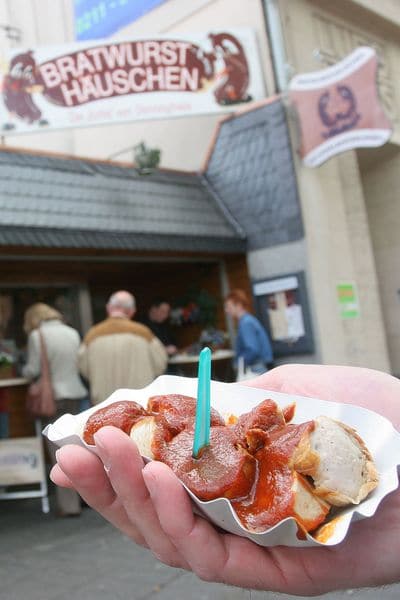
Berlin, Germany’s capital, is renowned for its many highly rated restaurants, making it a culinary destination on its own. But locals also chow down on more humble fare, especially Currywurst, a dish born in early post-World War II Berlin and now one of the favorite fast foods in all of Germany. Although Germany has many versions of this simple street food, classic Berliner Currywurst is a thick sausage cut crosswise into chunks, covered with a spicy tomato sauce, sprinkled with curry powder, and served with a small bread roll on the side.
Another popular postwar dish is Soljanka, a soup of Russian and Ukrainian origin, usually made from leftover meats or fish and perked up with pickles, olives, capers, and lemon. Frequently served in restaurants and canteens during the period when Germany was divided into two countries, Soljanka supposedly symbolized East Germany’s friendship with the Soviet Union. But when Germany reunified 25 years ago, Soljanka stayed on the menu even after political alliances changed and the Russian troops went home.

Pausing for a late-afternoon treat of Kaffee und Kuchen (coffee and cakes) is a tradition all over Germany. In the East, the selection of cakes usually includes several Blechkuchen, flat sheet cakes baked with one or more top layers of fruits, berries, custard cream, chocolate, or poppy seeds. And at Christmas-time, home cooks and professional bakers turn out stacks of oblong-shaped Stollen—a specialty of Dresden—butter-rich, light-textured fruitcakes enrobed in a winter cloak of confectioners’ sugar.
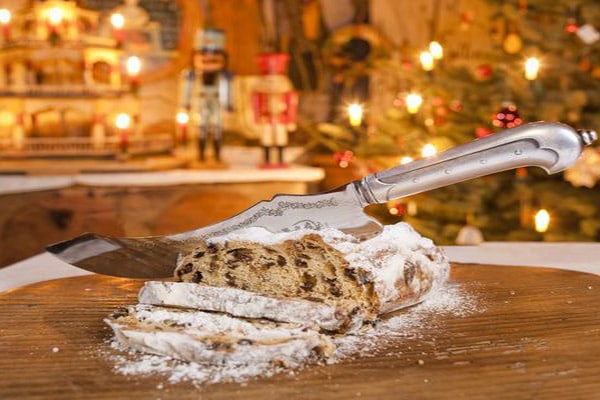
Dresden also sits astride the Elbe River, which flows through one of East Germany’s two wine regions. The other region, in nearby Saxony-Anhalt, has the most northerly vineyards in Germany, where the sparkling white wine Rotkäppchen is produced. During the first decades of the postwar socialist period, the red-capped bottles of bubbly were the festive drink of government officials and others who could afford it for special occasions. But since German reunification, Rotkäppchen’s popularity has spread westward; it’s now drunk in many places around Germany. Even traditions have a way of expanding beyond their borders and more than anything it’s this that defines Germany’s culinary scene. Travelers to Germany’s major cities are likely to encounter even more regional specialties from all four corners of the country there today, with both traditional and modern dishes on many menus. Hopefully, this guide will help you order without searching for a compass.
[alert type=white]
Where to Eat and Drink in Germany:
Munich
Ratskeller München
Nürnberg-Kornburg
Gasthof Weisses Lamm
Freiburg im Breisgau
Zum Roten Bären
Bremen
Bremen Ratskeller
Lübeck
Schiffergesellschaft
Erfurt
Köstrtizer Zum Güldenen Rade
Leipzig
Auerbachs Keller
www.auerbachs-keller-leipzig.de
[/alert]

